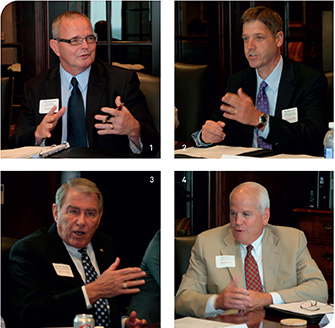
1.Jerry Jorgensen asked whether a drawdown in forces represented a flooding of the job market, or a true hiring opportunity for business. | 2. Many programs help veterans, Paul Holewinski said, but the efforts at times seem fragmented. | 3. Bob Ulin said the true consequences of force drawdown need to be clear to policy makers. | 4. Military spouses, said Don Giles, are in many cases gifted with special skills in their own right, and can contribute to business success.
A historical complication, said Bob Ulin, is the 35-mile stretch between Kansas City and Fort Leavenworth and the psychological gap it creates. When he was involved in the national security program up at the fort, he had a hard time getting people to come from Kansas to attend the program. “Those that did attend were shocked by what they saw,” said Ulin. “They thought the instruction was fabulous, the institution was tremendous, and they learned an awful lot about the military and this quality educational facility they have in their own region.”
To help narrow that distance, Paul Holewinski said, Armed Forces Bank holds an annual board meeting at Fort Leavenworth, which incudes a briefing
from Gen. Arter. In terms of getting more civic leaders up to the fort, Holewinski thought that it would help if there were “a perceived general openness.” He added, “I think that would go a long way towards linking Kansas City businesses into more general touch and reach of Fort Leavenworth.”
“Would it not be well for all of us sitting around the table who have contacts with other businesses in the Kansas City area to suggest something such as that?” said Gen. Arter. “As sure as I’m sitting here next to you, the leadership of Fort Leavenworth and the Combined Arms Center and Command and General Staff College would embrace such visits.”
Bob Ulin and a few others at the table already participate in an organization called the 27 Committee—so-named for the year Fort Leavenworth was established, 1827. “What we’re interested in is economic development for the region,” said Ulin, “both sides of the state line.” The focus of the committee is to make sure the people understand the economic impact of Fort Leavenworth, which is substantial.
“When you look at all the military, all the federal installations out of Fort Leavenworth, they generate a huge amount of money for our region—$5.5 billion, everything together,” said Ulin. When he showed these numbers to the top executive of a large bank in KC, “he was shocked,” Ulin said: “He had no idea the fort generates that much revenue.” As testament to its value, Ulin noted that Fort Leavenworth generates as much as 25 percent of the traffic at Kansas City Internat-ional Airport.
Impact of Reduction in Force
Given the economic importance to the area of the many bi-state military installations, including Fort Leavenworth, Fort Leonard Wood, Fort Riley, McConnell Air Force Base and Whiteman Air Force Base, Jerry Jorgensen asked his colleagues what they saw as the impact on the regional economy from the impending reduction in force. In terms of numbers, Bob Ulin observed that troop levels in general have been reduced from 540,000 to 490,000, with a target reduction as low as 420,000.
“You’re not looking at entire bases” being shut down, said Erik Bergrud. “You’re looking at programs and which programs might be moved.” Bergrud believes that Whiteman is the most vulnerable. He wondered what could be done as a community to forestall any severe cutbacks.
According to Mike Hockley, Fort Leavenworth is actually expanding and bringing new programs onto the base. The one down side is that the Army is not running as many students through the Command and General Staff College (CGSC ) as it once did.